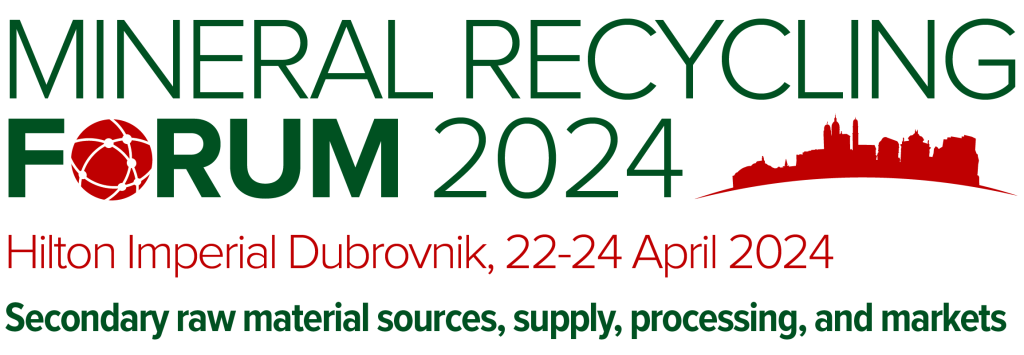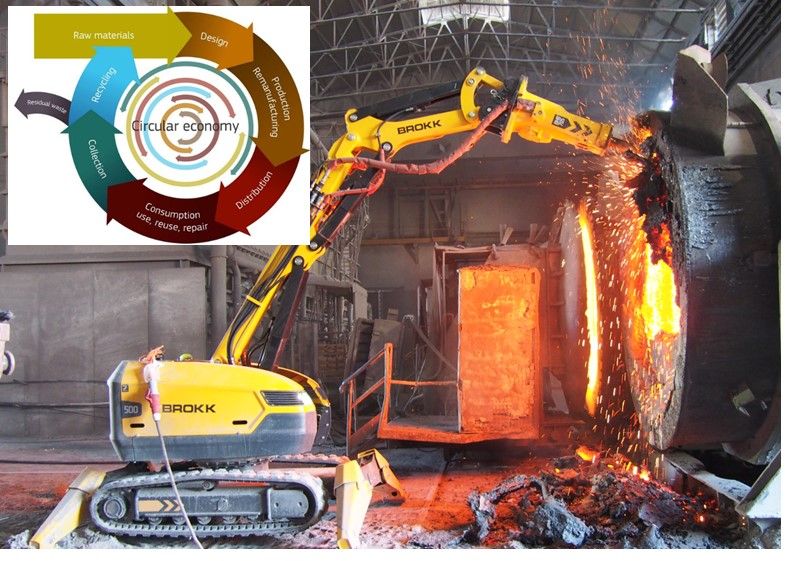“Squaring the circle” is a problem in geometry that was first proposed in Greek mathematics. The expression “squaring the circle” is also sometimes used as a metaphor for trying to do the “impossible”, and can also mean to bring together two things which are normally thought to be so different that they cannot exist together – so, refractories and recycling?
Actually, we know that these two have existed together for some decades, although it has hardly become a mainstream market sector…until now.
Title Image Breaking out: A Brokk 500 hydraulic breaker is used to tear out refractory linings in steelmaking vessels; it has been estimated that up to some 12m tpa of refractory waste is generated worldwide. With certain refractory mineral supply sources challenged, and a zero waste trend emerging across most manufacturing sectors, an uptick in refractory recycling is surely on the cards. Courtesy Brokk AB
As Constantine Beelitz, President Europe, CIS & Turkey, RHI Magnesita, so passionately expressed in his UNITECR 2023 Welcome Address last September: “We have not been taking the risks that we should be, to tackle the carbon challenge.” (see “Refractories Feast in Frankfurt!“). There’s clearly more work to do, and that includes recycling refractories.
Refractory recycling has very much started to go up a gear. This is a summary of a presentation given at UNITECR 2023, 28 September, Frankfurt.
For the latest trends in recycling refractories don’t miss
Confirmed Programme Announced
Presentations from:
REF Minerals | Glenn Hunter & Associates | Shinagawa Refractories | TRL Krosaki | HarbisonWalker International | RHI Magnesita | MIRECO & MORE
Full Details Here
A new era of refractory mineral recycling
Six primary drivers are stimulating this new era of refractory mineral recycling:
- Environment: saving the environment; drive for the “Circular Economy” gathering momentum; CO2 reduction; sustainable development of raw materials
- Cost factors: rising cost of primary minerals, energy, waste treatment, landfill; future penalties, legal costs
- Limited primary sources: shortage of commercially developed mineral resources and processing plants: “critical” + “strategic”; Source overreliance: risky overreliance on supply/trade from limited overseas sources; logistics stress; vulnerability spotlighted by Covid-19 pandemic, Russia-Ukraine war, China-Taiwan?
- China in change: supply issues, due to wide range of factors; end of an era for low cost import reliance? Time to de-risk and seek alternative sources?
- Emergence of hi-tech growth markets requiring “critical” raw materials: to become more mainstream, particularly in the energy sector (eg. Li-ion batteries, EVs, solar, wind), and thus demand for respective critical minerals (eg. lithium, graphite, rare earths); minerals “gaining criticality”; = increasing government awareness/reaction/support/investment
- Recycling technology more economic/established: evolving from esoteric, expensive sideshow in the past, to more mainstream processing line; advances in processing & sorting technology; opportunities sensed and sought after.
In Europe, the European Commission has been very active in the push towards a Circular Economy – “Closing the loop” – with a raft of policies and initiatives, notably:
2008+: EC Critical Raw Materials List
2014: Horizon 2020 Project Funding (-2027 Horizon Europe)
2019: European Green Deal
2020: Circular Economy Action Plan
2022: Critical Raw Materials Act (CRMA) proposed
2023: CRMA adopted; The Green Deal Industrial Plan
Amid the policy detail, are clear references to boosting industrial mineral recycling:
- a robust and integrated single market for secondary raw materials and by-products, requiring deeper co-operation across value chains.
- legal requirements to boost the market of secondary raw materials with mandatory recycled content
- build a more resilient supply chain: to support projects, attract more private investment for recycling (and mining & processing).
- European standardisation to fast-track secondary raw material production
And in June 2023, the EU Council announced proposals to improve the CRMA by raising the level of ambition for processing and recycling capacity from 40 to 50% for processing and from 15 to 20% for recycling, and adding Bauxite/Alumina (& Aluminium) as strategic raw and critical materials.
As EC President Ursula von der Leyen said at the World Economic Forum, Davos, 17 January 2023: “The next decades will see the greatest industrial transformation of our times – maybe of any times.”
At the same time, the last few years have witnessed increasing state government awareness and action in fast evolving assessments of “Critical” or “Strategic” minerals worldwide. This has yielded national critical mineral lists, state funding for mineral supply chains and recycling, and a host of organisations and alliances.
Crucially, this has resulted in a significant evolution and modification of refractory mineral supply chain options to enhance recycled raw material as an option for consumers (see chart).
Of supreme importance, is the requirement for players in different stages of the supply chain to co-operate with each other, in order to successfully “close the loop” efficiently, and economically.

Global trends & developments
There are some 20-25 industrial minerals essential to produce refractory products, and many have limited sources worldwide, and many are sourced from China (see table).

It has been estimated that some 7.6-12.6m. tpa of refractory waste is generated worldwide, and approximately 50% of this volume is reused in refractories production (Sabrina Salmen, RHI Magnesita (2022)).
Typical examples include: MgO-Cr bricks recycled as gunning mixes for steel furnaces and permanent lining bricks; MgO-C bricks widely recycled as they exhibit less contamination due to non wetting characteristics of C, recycled in low grade remanufactured MgO-C bricks and ramming masses; and alumina bricks from aluminium carbon bake furnaces reused as castable for furnace headwalls and floors (Navin Singh, Veolia Australia and New Zealand (2023)).
All aboard for invaluable networking opportunities in recycling
FULL DETAILS HERE
However, refractory recycling evolution and capability is far from uniform across the world, and different countries and regions are at different stages of development. Here is a brief summary (more detail in the presentation):
USA
- Limited recycling activity, mainly “open-loop”, “opportunistic”.
- Very few independent refractory recyclers, led by Glenn Hunter & Associates with >30 years with a zero land-fill policy, and recycling plants at Delta, Ohio and Kendallville, Indiana.
- Few, if any, incentives to recycle refractories as yet; landfill remains very low cost.
- Mineral recycling in general now emerging as a “megatrend” within North America, driven by government funding and supply chain disruption.
- But, momentum building among North American refractory producers for closed-loop recycling.
India
- About 250,000 tpa of spent refractory materials are recycled in market sectors; = c.15% of recycled raw materials being used on average.
- Indian aims to increase this to 25% by 2025, thus creating an additional use of 150,000 tonnes over the next 2 years.
- Overall, expected increase in refractory recycling within India, plus increased imports of secondary materials and refractory grogs.
- Very much driven by anticipated rise in refractory demand from steel, cement, glass, and national move to reduce refractory raw material import dependency (mainly from China).
- Challenges include only a limited quantity of recycled refractory is available; too many contaminants makes it difficult to recycle every refractory product
South Korea
- Recycling rate has increased from 33% in 2013 to 65% in 2019 driven by rising costs of landfill and environmental fees.
- Led by Korea Material Co. Ltd founded in 2011, and now with three recycling plants.
- Challenges include stigma of “tarnished” recycled materials; difficulties in controlling consistent chemical specifications; cost of recycling; increasing incentive to recycle but not much incentive to use recycled refractory raw material
China
- Recycling has been an established practice in the Chinese market for quite some time.
- Most activities are spread out across several small-sized suppliers and traders.
- Quality standards are quite different from Europe, but most Chinese refractory players are flexible enough to adapt recipes and products quickly to make full advantage of the usage of recycled material.
Japan
- The volume of recycled refractory raw materials used has fallen from >100,000 tpa to about 70,000 tpa from 2004 to 2019
- Challenges include a labour shortage for logistics/transportation & sorting/crushing processes; lack of storage space of used refractories; and mindset readjustment about recycling.
Europe
- Much more developed and progressing
- Mainly composed & driven by 15-20 independent/JV refractory recycling companies and EU-wide research consortiums of collaborating players from raw material, processing, refractory, & end use sectors
- Several very well-established recyclers; certain owned by larger industry players, certain with specific focus (eg. AZS glass ref.), recent trend to partner with refractory or steel producer.
- Overall, one can conclude with some primary challenges and opportunities or the growing sector of refractory mineral recycling.
Challenges
- Competitive: to be cost, quality, & performance competitive with primary raw materials
- Image: is using a “waste” product still a stigma?
- Quality control: issues in making the grade
- Adapting: recycling compatibility in established product formulations; a new mind-set encouraging recipe modification to “ease” recyclability; combined with new low-CO2 recipe
- Investment: in skilled labour; processing/sorting technology/automation; eg. hand sorting vs laser sorting?
- Incentivisation:
- Government/state support structure: CO2 “credits” in recycling?
- Tax/monetary drivers
- Landfill bans/penalties: “Landfill prices are so low in USA it is hard to justify doing anything.” Tom Vert, Strategic Refractory Consultant (2022)
- Permits/legislation: eg. in handling/storing/treating refractory waste material, clarity, consistency, across country borders
harmonisation of waste handling/permitting - Refractory waste source site:
- Simplified, structured schedule & process:
- Awareness & speed
- Supply chain:
- Sourcing, securing, accessing, and maintaining adequate supply of refractory waste material; waste source becomes the new “refractory mineral resource”
- Assurance: of long term supply of consistent quality of refractory SRM
- Costs
- Management: balance between continuous and discontinuous flows of waste material to meet consistent supply of recycled material flow to end users
Opportunities
- Recycled material on mineral purchaser’s menu: the future “new normal”, or regular sourcing option
- More government input = support & investment potential? Critical Raw Material policies; recycling initiatives
- More companies getting involved: evolution of new supply chain of:
- Waste sources: eg. steel, glass, cement, ceramics etc.
- Primary mineral producers: diversifying into recycling projects to expand portfolio and combined “package” to consumers
- Processors (Recyclers)
- Traders
- Distributors
- Logistics/Handling
- Suppliers of demolition/processing/quality control technology & equipment
- Increasing refractory recyclability globally: development of new product formulations to enhance/ease SRM use and ultimate recyclability to achieve Circular Economy
- Replicate progress & activity levels of EU worldwide
- Mindset of new manufacturing R&D with recycling at EOL
- Blends of primary and SRM?
- Provides mineral suppliers & mineral consumers with “green” portfolio branding
- Added value product development: for more diverse market applications
- Strategic partnerships: increasing long term strategic alliances and co-operation (technical + investment) between refractory waste sources, recyclers, and refractory producers
- Education: of end users to positively engage in and recognise benefits of recycling for Circular Economy = employment opportunities, better for environment
This is a summary of the presentation given by Mike O’Driscoll, Director, IMFORMED, at UNITECR 2023, 28 September, Frankfurt
For a FREE download of this presentation please click here | Any questions or enquiries to mike@imformed.com
For the latest trends in recycling refractories









